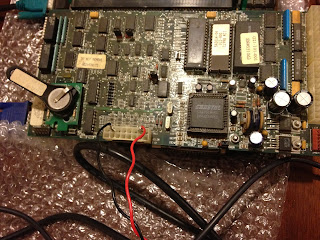The Merit Megatouch Bar/Table Top Game Machine
 |
| The Merit Megatouch Maxx (Saphire) |
 |
| Megatouch Force |
 |
| Merit Ion Megatouch (Courtesy of Jester's Amusements) |
While I don't really know much about the various product lines that Merit offered, I do know that the most common machines I saw were the CRT Merit Maxx (with its jewel themed updates) and the newer Megatouch Force.
I'm putting together a game room and a Merit Megatouch was something I hoped to incorporate right from the start. At first I looked at the modern LCD versions (such as the Aurora or Ion Lines). In my opinion, the prices were astoundingly high for the level of hardware. When I looked at older machines in various conditions, I again saw very high prices and a ver slow depreciation. This didn't bother me so much, as it gave me an excuse to DIY it and truly make it my own. Unfortunately, I found out that Merit does not license its software. Thus, the reason for the high prices is really the software as well as excellent customer support from Merit.
Choosing parts is also somewhat of a pain as Merit is very protective of its software (as is its right). Buying individual parts requires making sure your hardware and physical security key matches up with the Merit supplied hard drives. The best bet is to obtain a working machine with defective screen and/or in physical disrepair, but functional inside (easier said than done).
So here is the motherboard:
 |
| Megatouch XL with Maxx Diamond conversion |
I again want to point out (both for my own protection and to state a fact). This is a native Merit board, HDD, I/O card, and security key (the object with the battery and tag in the lower left corner of the motherboard). The AT power source is new and replaces a defective one. This is in NO WAY a hacked board and there is absolutely NO use of cracked or stolen/pirated or otherwise altered software. Instead this is a genuine Merit Megatouch with some working parts (motherboard, I/O, HDD) and some non-working/damaged parts (powersource, touchscreen, CRT, enclosure) that I am replacing with available alternatives.
 |
| Booting is slow, the fan is loud, but it works |
 |
| The 17" ELO 1715L |
 |
| First run - Touchscreen not Calibrated |
 |
| The Menu Control connected to Momentary switch |
http://home.comcast.net/~dark.paladin/megatouch/
He reveals the 4 important pins including the two grounds at the top left and second from left, as well as the setup pin (top right) and Touchscreen calibration pin (second from right on top). Using a momentary switch to temporarily ground these switches will send you to the Setup and Touch Calibration Menus respectively. His design is definitely worth a read to anyone considering a similar project.
 |
| Touch Screen Working ... Photo Hunt Time |
But the first thing to consider is the permanent housing. The motherboard is way too bid for the iMac G4 and too wide for the iMac G5. However, the other white plastic desktop of the era I feel would make an ideal home. I am referring to the 17" Flat CRT based eMac. Elimination of the CRT will give plenty of room for the PSU, Motherboard, I/O and HDD. Cooling mechanisms and air flow are already present in the chassis. In addition, my current 4:3 17" LCD should fit perfectly. Despite this transition, because the CRT in the eMax is actually flat, it should be indistinguishable from the outside.
The I/O hub can be fitted with the momentary switches and the existing on/off button can be used. The existing front speakers seem perfect for this mod.
 |
| Broken eMac = Future Megatouch? |
All in all, I think this will make a very fun project while I await small form factor Ivy Bridge Boards for my new Pro iMac G4 mod.
Please feel free to ask any questions and as always, thanks for reading.
TO BE CONTINUED ........




